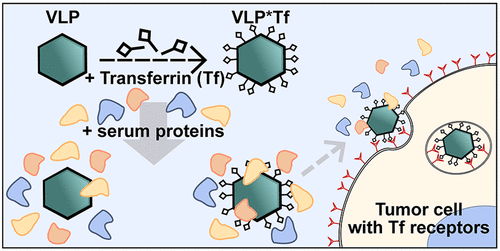当前位置:
X-MOL 学术
›
Bioconjugate Chem.
›
论文详情
Our official English website, www.x-mol.net, welcomes your
feedback! (Note: you will need to create a separate account there.)
The Protein Corona Does Not Influence Receptor-Mediated Targeting of Virus-like Particles.
Bioconjugate Chemistry ( IF 4.0 ) Pub Date : 2020-05-08 , DOI: 10.1021/acs.bioconjchem.0c00240 Jirina Zackova Suchanova 1 , Alzbeta Hejtmankova 1 , Jitka Neburkova 2 , Petr Cigler 2 , Jitka Forstova 1 , Hana Spanielova 1, 2
Bioconjugate Chemistry ( IF 4.0 ) Pub Date : 2020-05-08 , DOI: 10.1021/acs.bioconjchem.0c00240 Jirina Zackova Suchanova 1 , Alzbeta Hejtmankova 1 , Jitka Neburkova 2 , Petr Cigler 2 , Jitka Forstova 1 , Hana Spanielova 1, 2
Affiliation

|
Protein corona formation has been regarded as an obstacle to developing diagnostic and therapeutic nanoparticles for in vivo applications. Serum proteins that assemble around nanoparticles can hinder their targeting efficiency. Virus-based nanoparticles should be naturally predisposed to evade such barriers in host organisms. Here, we demonstrate that virus-like particles derived from mouse polyomavirus do not form a rich protein corona. These particles can be efficiently targeted to cells that overproduce transferrin receptors, e.g., cancer cells, by conjugating transferrin to the particle surface. In this study, we provide evidence that the interaction of virus-like particles with their newly assigned target receptor is not obstructed by serum proteins. The particles enter target cells via a clathrin-dependent endocytic pathway that is not naturally used by the virus. Our results support the notion that the natural properties of virus-like particles make them well-suited for development of nanosized theranostic tools resistant to detargeting by protein coronas.
中文翻译:

蛋白电晕不影响病毒介导的病毒样颗粒的介导靶向。
蛋白电晕的形成已被认为是开发用于体内应用的诊断和治疗性纳米颗粒的障碍。围绕纳米粒子聚集的血清蛋白可能会阻碍其靶向效率。基于病毒的纳米粒子应自然易避开宿主生物体中的此类屏障。在这里,我们证明了源自小鼠多瘤病毒的病毒样颗粒不会形成丰富的蛋白质电晕。通过将转铁蛋白缀合至颗粒表面,可以将这些颗粒有效地靶向过量产生转铁蛋白受体的细胞,例如癌细胞。在这项研究中,我们提供的证据表明,血清蛋白不会阻碍病毒样颗粒与其新分配的靶标受体的相互作用。颗粒通过网格蛋白依赖性的内吞途径进入靶细胞,而该途径不是病毒天然使用的。我们的研究结果支持了这样的观念,即病毒样颗粒的自然特性使其非常适合开发抗蛋白质电晕脱靶的纳米治疗方法。
更新日期:2020-04-24
中文翻译:

蛋白电晕不影响病毒介导的病毒样颗粒的介导靶向。
蛋白电晕的形成已被认为是开发用于体内应用的诊断和治疗性纳米颗粒的障碍。围绕纳米粒子聚集的血清蛋白可能会阻碍其靶向效率。基于病毒的纳米粒子应自然易避开宿主生物体中的此类屏障。在这里,我们证明了源自小鼠多瘤病毒的病毒样颗粒不会形成丰富的蛋白质电晕。通过将转铁蛋白缀合至颗粒表面,可以将这些颗粒有效地靶向过量产生转铁蛋白受体的细胞,例如癌细胞。在这项研究中,我们提供的证据表明,血清蛋白不会阻碍病毒样颗粒与其新分配的靶标受体的相互作用。颗粒通过网格蛋白依赖性的内吞途径进入靶细胞,而该途径不是病毒天然使用的。我们的研究结果支持了这样的观念,即病毒样颗粒的自然特性使其非常适合开发抗蛋白质电晕脱靶的纳米治疗方法。











































 京公网安备 11010802027423号
京公网安备 11010802027423号